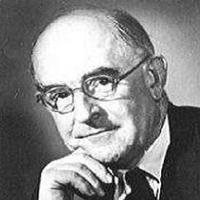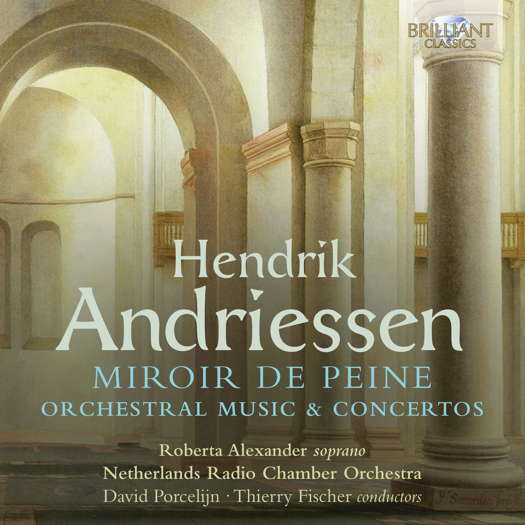- Helmut Müller-Brühl
- Vilém Tauský
- Joshua Habermann
- Kari Løvaas
- SWR Music
- Juilliard
- Firenze
- Bobbi J Nicotera
 DISCUSSION: John Dante Prevedini leads a discussion about Music and the Visual World, including contributions from Celia Craig, Halida Dinova and Yekaterina Lebedeva.
DISCUSSION: John Dante Prevedini leads a discussion about Music and the Visual World, including contributions from Celia Craig, Halida Dinova and Yekaterina Lebedeva.
 SPONSORED: Ensemble. Unjustly Neglected - In this specially extended feature, Armstrong Gibbs' re-discovered 'Passion according to St Luke' impresses Roderic Dunnett.
SPONSORED: Ensemble. Unjustly Neglected - In this specially extended feature, Armstrong Gibbs' re-discovered 'Passion according to St Luke' impresses Roderic Dunnett.
All sponsored features >>

Beautifully Crafted
Music by Dutch composer Hendrik Andriessen, recommended by GEOFF PEARCE
'... absolutely inspirational ...'
This is a lovely disc of music by Hendrik Andriessen (1892-1981), a composer from the Netherlands and from a family well known for its musicians. His father was a musician, his brother an organist and composer, two of his sons are/were composers and his daughter was a flautist. He was a teacher of composition and was well-known in his lifetime as an organist and very skilful improvisor on that instrument. His list of compositions is not especially large, but his music is finely crafted. He tended to look backwards for his musical inspiration and his music is very listenable. This disc is a fine example of some of his compositions.
The first work, Miroir de Peine, was written in 1923 and orchestrated ten years later. It is based on five sonnets of Henri Gheon, depicting the sufferings of Jesus from Mary's standpoint. The first, 'Agonie au Jardin', is slow and sad, reminding me of Duparc more than anyone else. It is beautifully played and sung. Roberta Alexander reveals herself as one completely at home with this work, and her music soars serenely.
Listen — Andriessen: Agonie au jardin (Miroir de Peine)
(track 1, 2:26-3:11) ℗ 1992 NM Classics :
The fourth song, 'Portement de Croix', depicts Jesus staggering under the weight of the cross. It is somewhat weary and heavy, and very effective at setting the mood.
Listen — Andriessen: Portement de Croix (Miroir de Peine)
(track 4, 1:27-2:09) ℗ 1992 NM Classics :
The final movement is charged with sadness, suffering and a sense of transcendence. As in the rest of the cycle, the orchestration is just for strings, and by and large, they provide backing for the vocalist but seldom have solo entries. The feeling, stylistically, is one of antiquity.
This work is followed by a song, Magna res est amor from 1919. This piece, scored for larger forces, is a setting of a poem by Thomas a Kempis. It is lush and romantic but there is restraint, too, and again it reminds me of some of the French composers from around the turn of the century. Some of the harmonic shifts are almost in the world of Richard Strauss's Four Last Songs, of a later period.
Listen — Andriessen: Magna res est amor
(track 6, 0:03-0:50) ℗ 1992 NM Classics :
This is followed by the short song Fiat Domine, written a year later, and also a setting of a Kempis poem.
Perhaps one could say that, in the harmonic structure, Andriessen owes much to Alfons Diepenbrock, while with the orchestrations and vocal lines, he owes more to those late nineteenth/early twentieth century French composers.
The thirteen minute Variations and Fugue on a theme of Kuhnau, composed in 1935, is really free fantasies based on different aspects. This music is fairly traditional and reveres the past. I think that this work is one of the composer's best-known works. It is set for strings alone and reminds me of some of the excellent British string music of around the same time. It truly is an excellent work for string ensemble and the double fugue is quite exultant and well crafted.
Listen — Andriessen: Variations and Fugue on a theme of Kuhnau
(track 8, 12:00-12:45) ℗ 1992 NM Classics :
Variations of a theme by Couperin, written in 1944 for the composer's flautist daughter Heleen, is slightly longer, scored for strings, flute and harp, and is again a fine example of this skilled composer. Paul Verheij, the very fine flautist on this recording, plays without a hint of shrillness.
Listen — Andriessen: Variations of a theme by Couperin
(track 9, 4:11-4:52) ℗ 1992 NM Classics :
The title of the Chromatic Variations, composed in 1970 on an original theme, refers to the theme's chromatic nature. There is some lovely playing in this thirteen minute piece for orchestra and assorted soloists, especially by the oboe, solo violin, cello and flute. There are a lot of changes in this music, and the craftsmanship, as in all the works here, is evident. This was one of the composer's last works.
The two movement Cello Concertino was also composed in 1970. Here the composer looks back at the music of Bach, blending this with a Romantic spirit. The excellent cellist on this recording, Michael Muller, plays this beautifully lyrical and heartfelt work. The first movement starts slowly but a more lively Allegro soon makes itself felt. It is contrapuntal in nature, and whilst it is not generally a virtuoso showpiece for the cello, there are certainly moments when it is. It certainly shines as an expressive vehicle for the soloist. The slow opening returns towards the end of the movement, which, after a brief cadenza, then closes as serenely as it opens. The second movement is a totally different affair, dance-like and with much showier cello writing, which would keep any soloist on his toes. This is a very fine performance indeed.
Listen — Andriessen: Allegro con spirito (Cello Concertino)
(track 12, 1:00-1:50) ℗ 1999 NM Classics :
The three-movement Concertino for oboe was also written in 1970. Andriessen, in his concerto writing, eschewed writing in a way that pitted the solo instrumentalist against the orchestra, and tended to write so that the soloist emerged from it. Henk Swinnen is a very fine oboist and performs magnificently here. He never forces his sound, phrases instinctively and his warm and lovely rounded bright sound is a delight. I would like to hear this beautifully lyrical work played more often. The orchestral accompaniment is for strings, giving a contrast of timbre with the soloist. This has much in common with some of the oboe works written by mid twentieth century English composers. The second movement, 'Aria', is so beautiful that I regard it as one of this disc's high points.
Listen — Andriessen: Aria (Concertino for Oboe with String Orchestra)
(track 14, 1:24-2:21) ℗ 1999 NM Classics :
The last movement 'Fugato a capriccio' reveals the playful side of the oboe. It requires deft finger work and precise articulation, and Henk Swinnen certainly rises magnificently to the challenge.
Listen — Andriessen: Fugato a capriccio (Concertino for Oboe with String Orchestra)
(track 15, 2:44-3:30) ℗ 1999 NM Classics :
Romantic in nature, the Canzona for Cello and Orchestra, dating from 1965, also looks back to Bach. This is not a flashy work, but a rather brooding and intense piece lasting about twelve minutes, again with Michael Muller as soloist, providing as faultless a performance as he did in the Concertino.
The final work is the three movement Violin Concerto, composed in 1969. Here he apparently modelled this work on the Mendelssohn E minor Violin Concerto, employing a similar three movement structure with a similar character to each movement, and there are even a few thematic references. This is quite a Romantic work and the writing for the soloist is much more concerto like and virtuosic at times, but this is not the typical soloist-verses-orchestra work. This is especially true of the second movement, where the soloist is much more a part of the orchestra. Tinta Schmidt von Altenstadt is a very fine artist, producing a glorious sound, impressive technique and intonation, and some beautifully lyrical playing. This is also a concerto that should be performed much more. It would make a great piece for violin competitions.
Listen — Andriessen: Allegro vivace (Concerto for Violin and Orchestra)
(track 19, 1:56-2:45) ℗ 1999 NM Classics :
I think Hendrik Andriessen is a composer who deserves much greater exposure worldwide than he currently gets. Perhaps this is due to the fact that he writes in an accessible and lyrical style, which is perhaps out of step with a lot of twentieth century music. However, his music is so beautifully crafted and assured that I feel his time will come, and I do hope that this recording kindles increasing awareness of this very fine composer, especially for his concerto works and also for the lovely song cycle that opens the disc.
The performances on the whole disc are absolutely inspirational, the recordings sound very clear, with the right amount of presence, and it felt as if I was actually present. Do yourself a favour and buy this recording.
Copyright © 27 June 2021
Geoff Pearce,
Sydney, Australia

CD INFORMATION - HENDRIK ANDRIESSEN: MIROIR DE PEINE
MORE NETHERLANDS CLASSICAL MUSIC ARTICLES


